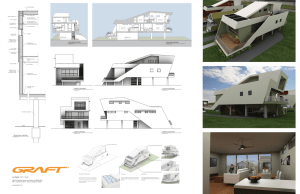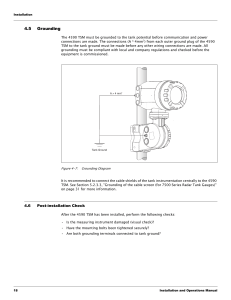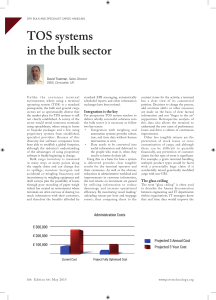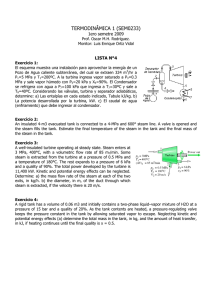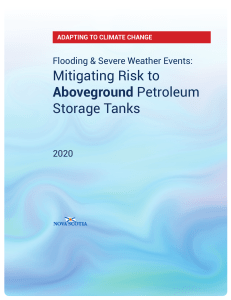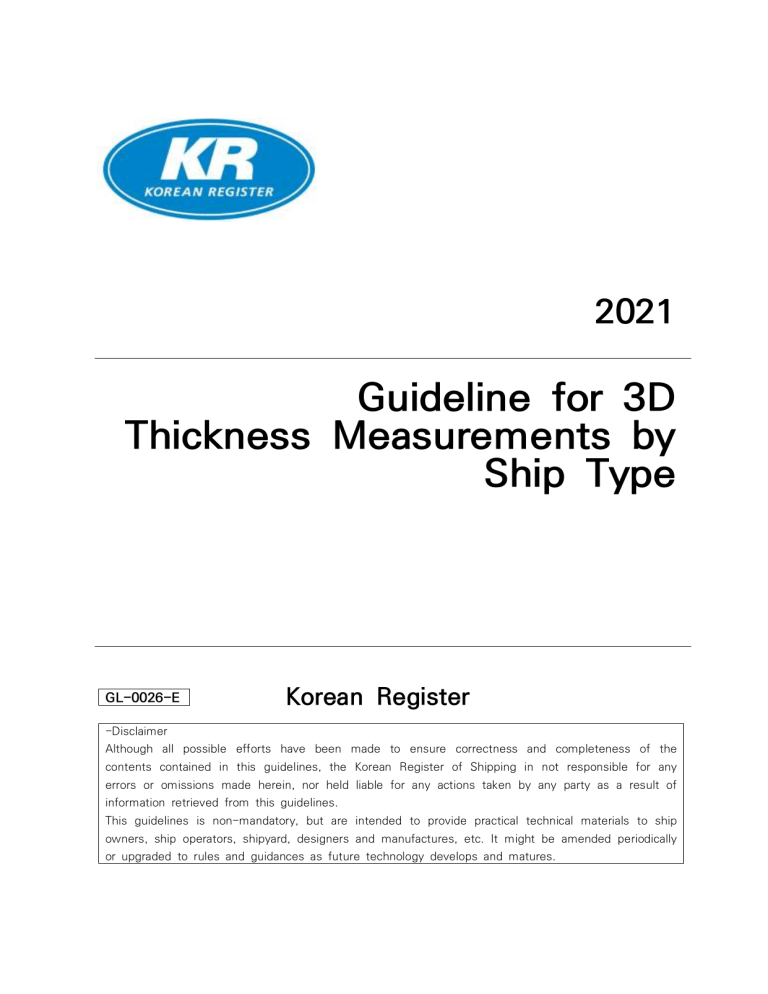
2021 Guideline for 3D Thickness Measurements by Ship Type GL-0026-E Korean Register -Disclaimer Although all possible efforts have been made to ensure correctness and completeness of the contents contained in this guidelines, the Korean Register of Shipping in not responsible for any errors or omissions made herein, nor held liable for any actions taken by any party as a result of information retrieved from this guidelines. This guidelines is non-mandatory, but are intended to provide practical technical materials to ship owners, ship operators, shipyard, designers and manufactures, etc. It might be amended periodically or upgraded to rules and guidances as future technology develops and matures. 2021 Guideline for 3D Thickness Measurements by Ship Type GL-0026-E Korean Register -Disclaimer Although all possible efforts have been made to ensure correctness and completeness of the contents contained in this guidelines, the Korean Register of Shipping in not responsible for any errors or omissions made herein, nor held liable for any actions taken by any party as a result of information retrieved from this guidelines. This guidelines is non-mandatory, but are intended to provide practical technical materials to ship owners, ship operators, shipyard, designers and manufactures, etc. It might be amended periodically or upgraded to rules and guidances as future technology develops and matures. CONTENTS SECTION 1 General ....................................................................................................... 1 101. Purpose ...................................................................................................................1 101. Application.................................................................................................................1 SECTION 2 Minimum requirements for TMs at Special Survey by Ship Types ........ 2 201. General Ships .......................................................................................................... 2 202. General Dry Cargo Ships......................................................................................... 7 203. Liquefied Gas Carriers............................................................................................. 20 204. Bulk Carriers ........................................................................................................... 30 205. Double Hull Chemical Tankers................................................................................ 44 206. Double Hull Oil Takers............................................................................................. 58 207. Double Hull Bulk Carriers......................................................................................... 71 Chapter 1 General 101. Purpose This Guideline converts the two-dimensional illustrations into three-dimensional illustrations for the requirements of thickness measurement at each Special Survey related to Tables 4 through 13 of Pt 1, Annex 1-5 of the Rules for the Classification of Steel Ships. The purpose of this Guideline is for internal and external customers to easily understand the requirements of the thickness measurements at each Special Survey. 102. Application 1. This Guideline applies to all types of steel ships registered to the Society. However, if duplicated survey items are exist, these are not to be applied twice. 2. In case there is any discrepancy between this Guideline and the Rules for the Classification of Steel Ships, then the Rules shall prevail. - 1 - CHAPTER 2 Minimum requirements for TMs at Special Survey by Ship Types 201. General Ships For the minimum requirements for thickness measurements of General Ships, refer to Pt 1, Ch 2, Sec 4 Table 1.2.4, 1. General Ships of the Rules 1. Special Survey No. 1 1) Suspect areas throughout the vessel 2. Special Survey No. 2 1) Suspect areas throughout the vessel 2) One transverse section of deck plating in way of a cargo space within the amidships 0.5 3. Special Survey No. 3 1) Suspect areas throughout the vessel 2) Two transverse sections within the amidships 0.5 in way of two different cargo spaces 4), 5), 6), 7) - 2 - 3) All cargo hold hatch covers and coamings (plating and stiffeners) 9) 4) Internals in forepeak and afterpeak water ballast tanks 5) All transverse bulkheads in all cargo tanks (This requirement is to be applied only for tankers(including barges) carrying liquid cargo.) 6) All transverse bulkheads in all ballast tanks (This requirement is to be applied only for tankers(including barges) carrying liquid cargo.) - 3 - 4. Special Survey No. 4 and Subsequent 1) Suspect areas throughout the vessel 2) A minimum of three transverse sections in way of cargo spaces within the amidships 0.5 5), 6), 7) 3) All cargo hold hatch covers and coamings (plating and stiffeners) 9) 4) Internals in forepeak and aftpeak water ballast tanks - 4 - 5) All exposed main deck plating full length 6) Representative exposed superstructure deck plating (poop, bridge and forecastle deck) 7) Lowest strake and strakes in way of 'tween decks of all transverse bulkheads in cargo spaces together with internals in way - 5 - 8) All wind and water strakes, port and starboard, full length 9) All keel plates full length. Also, additional bottom plates in way of cofferdams, machinery space and aft end of tanks 10) Plating of seachests. Shell plating in way of overboard discharges as considered necessary by the attending Surveyor 11) All transverse bulkheads and one web frame ring in all cargo tanks 8) (This requirement is to be applied only for tankers(including barges) carrying liquid cargo.) 12) All transverse bulkheads and all web frame ring in all ballast tanks 8) (This requirement is to be applied only for tankers(including barges) carrying liquid cargo.) - 6 - 202. General Dry Cargo Ships For the minimum requirements for thickness measurements of General Dry Cargo Ships, refer to Pt 1, Ch 2, Sec. 15 Table 1.2.8(Minimum requirements for Close-up Survey) and Table 1.2.9(Minimum requirements of thickness measurements) of the Rules 1. Special Survey No. 1 1) Suspect areas 2. Special Survey No. 2 1) Suspect areas 2) One transverse section of deck plating in way of a cargo length area within the amidships 0.5 3) Measurement for general assessment and recording of corrosion pattern of those structural members subject to Close-up Survey according to Table 1.2.8 i) Selected shell frames in all cargo holds and 'tween deck spaces (*1) ii) One transverse bulkhead in each cargo hold (*2) - 7 - iii) Forward and aft transverse bulkhead in one side ballast tank, including stiffening system (*2) iv) One transverse web with associated plating and framing in two representative ballast tanks of each type (i.e. topside, hopper side, side tank or double bottom tank) (*3) v) All cargo hold hatch covers and coamings (plating and stiffeners)(*4) - 8 - vi) Selected areas of all deck plating and underdeck structure inside line of hatch openings between cargo hold hatches (*5) vii) Selected areas of inner bottom plating (*6) 3. Special Survey No. 3 1) Suspect areas 2) Two transverse sections within the amidships 0.5 in way of two different cargo spaces 2) - 9 - 3) Measurement for general assessment and recording of corrosion pattern of those structural members subject to Close-up Survey according to Table 1.2.8 i) All shell frames in the forward lower cargo hold and 25 % frames in each of the remaining cargo holds and 'tween deck spaces including upper and lower end attachments and adjacent shell plating (*1) ii) All cargo hold transverse bulkheads (*2) iii) All transverse bulkheads in ballast tanks, including stiffening system (*2) - 10 - iv) All transverse webs with associated plating and framing in each ballast tank (*3) v) All cargo hold hatch covers and coamings (plating and stiffeners)(*4) vi) All deck plating and underdeck structure inside line of hatch openings between cargo hold hatches (*5) - 11 - vii) All areas of inner bottom plating (*6) 4) Within the cargo length area, each deck plate outside line of cargo hatch openings 5) All wind and water strakes within the cargo length area - 12 - 6) Selected wind and water strakes outside the cargo length area * Common requirements as general ships Internals in forepeak and aftpeak water ballast tanks - 13 - 4. Special Survey No.4 and Subsequent 1) Suspect areas 2) Within the cargo length area: i) A minimum of three transverse sections within the amidships 0.5 2) ii) Each deck plate outside line of cargo hatch openings iii) Each bottom plate, including lower turn of bilge - 14 - iv) Duct keel or pipe tunnel plating and internals 3) Measurement for general assessment and recording of corrosion pattern of those structural members subject to Close-up Survey according to Table 1.2.8 i) All shell frames in all cargo holds and 'tween deck spaces including upper and lower end attachments and adjacent shell plating (*1) ii) All cargo hold transverse bulkheads (*2) - 15 - iii) All transverse bulkheads in ballast tanks, including stiffening system (*2) iv) All transverse webs with associated plating and framing in each ballast tank (*3) v) All cargo hold hatch covers and coamings (plating and stiffeners)(*4) - 16 - vi) All deck plating and underdeck structure inside line of hatch openings between cargo hold hatches (*5) vii) All areas of inner bottom plating (*6) 4) All wind and water strakes full length - 17 - * Common requirements as general ships Internals in forepeak and aftpeak water ballast tanks All exposed main deck plating full length Representative exposed superstructure deck plating (poop, bridge and forecastle deck) - 18 - All keel plates full length. Also, additional bottom plates in way of cofferdams, machinery space and aft end of tanks Plating of seachests. Shell plating in way of overboard discharges as considered necessary by the attending Surveyor - 19 - 203. Liquefied Gas Carriers For the minimum requirements for thickness measurements of Liquefied Gas Carriers, refer to Pt 1, Ch 2, Sec. 16 Table 1.2.10(Minimum requirements for Close-up Survey) and Table 1.2.11(Minimum requirements of thickness measurements) of the Rules. 1. Special Survey No. 1 1) Suspect areas 2) One section of deck plating for the full beam of the ship within 0.5 amidships in way of a ballast tank, if any 3) Measurement for general assessment and recording of corrosion pattern of those structural members subject to Close-up Survey according to Table 1.2.10 i) One web frame in a representative ballast tank of the topside, hopper side and double hull side type (*1) - 20 - ii) One transverse bulkhead in a ballast tank (*3) 2. Special Survey No. 2 1) Suspect areas 2) Within the cargo area: i) Each deck plate ii) One transverse section within 0.5 amidships in way of a ballast tank, if any - 21 - 3) Selected wind and water strakes outside the cargo area 4) Measurement for general assessment and recording of corrosion pattern of those structural members subject to Close-up Survey according to Table 1.2.10 i) All web frame in a ballast tank, which is to be a double hull side tank or a topside tank. If such tanks are not fitted, another ballast tank is to be selected. (*1) ii) One web frame in each remaining ballast tank (*1) - 22 - iii) One transverse bulkhead in each ballast tank (*2) 3. Special Survey No. 3 1) Suspect areas 2) Within the cargo area: i) Each deck plate ii) Two transverse sections 1) - 23 - iii) All wind and water strakes 3) Selected wind and water strakes outside the cargo area 4) Measurement for general assessment and recording of corrosion pattern of those structural members subject to Close-up Survey according to Table 1.2.10 i) All web frame frames in all ballast tanks. (*1) - 24 - ii) All transverse bulkheads in all ballast tanks (*2) * Common requirements as general ships Internals in forepeak and aftpeak water ballast tanks - 25 - 4. Special Survey No. 4 and Subsequent 1) Suspect areas 2) Within the cargo area : i) Each deck plate ii) Three transverse sections 1) iii) Each bottom plate - 26 - iv) Duct keel plating and internals 3) All wind and water strakes, full length 4) Measurement for general assessment and recording of corrosion pattern of those structural members subject to Close-up Survey according to Table 1.2.10 i) All web frame frames in all ballast tanks. (*1) - 27 - ii) All transverse bulkheads in all ballast tanks (*2) * Common requirements as general ships Internals in forepeak and aftpeak water ballast tanks All exposed main deck plating full length - 28 - Representative exposed superstructure deck plating (poop, bridge and forecastle deck) All keel plates full length. Also, additional bottom plates in way of cofferdams, machinery space and aft end of tanks Plating of seachests. Shell plating in way of overboard discharges as considered necessary by the attending Surveyor - 29 - 204. Bulk Carriers For the minimum requirements for thickness measurements of Bulk Carriers, refer to Pt 1, Ch 3, Sec 4 Table 1.3.1(Minimum requirements for Close-up Survey) and Table 1.3.2(Minimum requirements of thickness measurements) of the Rules. 1. Special Survey No. 1 1) Suspect areas 2. Special Survey No. 2 1) Suspect areas 2) Within the cargo length: i) Two transverse sections of deck plating outside line of cargo hatch openings 3) i) Wind and water strakes in way of the transverse sections considered under 2) above ii) Selected wind and water strakes outside the cargo length area - 30 - 4) Measurement, for general assessment and recording of corrosion pattern, of those structural members subject to Close-up Survey according to Table 1.3.1 i) All shell frames in the forward cargo hold and 25% of shell frames in each of the remaining cargo holds including upper and lower end attachments and adjacent shell plating. For bulk carriers 100,000 DWT and above, all shell frames in the forward cargo hold and 50% of shell frames in each of the remaining cargo holds, including upper and lower end attachments and adjacent shell plating. (*1) ii) One transverse web with associated plating and longitudinals in each ballast tank (*2) iii) Forward and aft transverse bulkhead in one ballast tank, including stiffening system (*2) - 31 - iv) All cargo hold transverse bulkheads, including internal structure of upper and lower stools, where fitted (*3) v) All cargo hold hatch covers and coamings (plating and stiffeners) (*4) vi) All deck plating and under deck structure inside line of hatch openings between all cargo hold hatches. (*5) - 32 - 5) See 201. 1 (4), Pt 7, Ch 3, Sec 17 and the separate requirements specified by the Society for additional thickness measurement guidelines applicable to the side shell frames and brackets on ships subject to compliance with IACS UR S31 3. Special Survey No. 3 1) Suspect areas 2) Within the cargo length : i) Each deck plate outside line of cargo hatch openings ii) Two Transverse Sections, one in the amidship area, outside line of cargo hatch openings - 33 - iii) All wind and water strakes 3) Selected wind and water strakes outside the cargo length area 4) Measurement, for general assessment and recording of corrosion pattern, of those structural members subject to Close-up Survey according to Table 1.3.1 i) All shell frames in the forward and one other selected cargo hold and 50% of frames in each of the remaining cargo holds, including upper and lower end attachments and adjacent shell plating (*1) - 34 - ii) All transverse webs with associated plating and longitudinals in each ballast tank (*2) iii) All transverse bulkheads in ballast tanks, including stiffening system (*2) iv) All cargo hold transverse bulkheads, including internal structure of upper and lower stools, where fitted (*3) - 35 - v) All cargo hold hatch covers and coamings (plating and stiffeners) (*4) vi) All deck plating and under deck structure inside line of hatch openings between all cargo hold hatches. (*5) 5) Pt 1, See 201. 1 (3) of the Rules and Annex 1-5, Table 9 of the Guidance for additional thickness measurement guidelines applicable to the vertically corrugated transverse watertight bulkhead between cargo hold Nos. 1 and 2 on ships subject to compliance with IACS URs S19 and S23 - 36 - 6) See Pt 1, 201. 1 (4), Pt 7, Ch 3, Sec 17 of the Rules and the separate requirements specified by the Society for additional thickness measurement guidelines applicable to the side shell frames and brackets on ships subject to compliance with IACS UR S31 * Common requirements as general ships Internals in forepeak and aftpeak water ballast tanks - 37 - 4. Special Survey No. 4 and Subsequent 1) Suspect areas 2) Within the cargo length: i) Each deck plate outside line of cargo hatch openings ii) Three Transverse Sections, one in the amidship area, outside line of cargo hatch openings iii) Each bottom plate - 38 - 3) All wind and water strakes, full length 4) Measurement, for general assessment and recording of corrosion pattern, of those structural members subject to Close-up Survey according to Table 1.3.1 i) All shell frames in all cargo holds, including upper and lower end attachments and adjacent shell plating (*1) ii) All transverse webs with associated plating and longitudinals in each ballast tank (*2) - 39 - iii) All transverse bulkheads in ballast tanks, including stiffening system (*2) iv) All cargo hold transverse bulkheads, including internal structure of upper and lower stools, where fitted (*3) v) All cargo hold hatch covers and coamings (plating and stiffeners) (*4) - 40 - vi) All deck plating and under deck structure inside line of hatch openings between all cargo hold hatches. (*5) 5) See Pt 1, 201. 1 (3) of the Rules and Annex 1-5, Table 9 of the Guidance for additional thickness measurement guidelines applicable to the vertically corrugated transverse watertight bulkhead between cargo hold Nos. 1 and 2 on ships subject to compliance with IACS URs S19 and S23 6) See Pt 1, 201. 1 (4), Pt 7, Ch 3, Sec 17 of the Rules and the separate requirements specified by the Society for additional thickness measurement guidelines applicable to the side shell frames and brackets on ships subject to compliance with IACS UR S31 - 41 - * Common requirements as general ships Internals in forepeak and aftpeak water ballast tanks All exposed main deck plating full length Representative exposed superstructure deck plating (poop, bridge and forecastle deck) - 42 - All keel plates full length. Also, additional bottom plates in way of cofferdams, machinery space and aft end of tanks Plating of seachests. Shell plating in way of overboard discharges as considered necessary by the attending Surveyor - 43 - 205. Double Skin Chemical Tankers For the minimum requirements for thickness measurements of Double Skin Chemical Tankers, refer to Pt 1, Ch 3, Sec 4 Table 1.3.7 2)(Minimum requirements for Close-up Survey) and Table 1.3.8(Minimum requirements of thickness measurements)of the Rules. 1. Special Survey No. 1 1) Suspect areas 2) One transverse section of deck plating for the full beam of the ship within the cargo area (in way of a ballast tank, if any, or a cargo tank used primarily for water ballast) 3) Measurements, for general assessment and recording of corrosion pattern, of those structural members subject to Close-up Survey according to Table 1.3.7 2) i) One web frame ring in a ballast double hull tank 2) (Web frame in a ballast tank means vertical web in side tank, hopper web in hopper tank, floor in double bottom tank and deck transverse in double deck tank(where fitted), including adjacent structural members. In fore and aft peak tanks web frame means a complete transverse web frame ring including adjacent structural members) - 44 - ii) One deck transverse in a cargo tank or on deck ( 2) iii) One transverse bulkhead in a ballast tank 2) ( 4) iv) One transverse bulkhead in a cargo wing tank ( 5) - 45 - v) One transverse bulkhead in a cargo centre tank 3) ( 5) 2. Special Survey No. 2 1) Suspect areas 2) Within the cargo area : i) Each deck plate ii) One transverse section - 46 - 3) Measurements, for general assessment and recording of corrosion pattern, of those structural members subject to Close-up Survey according to Table 1.3.7 2) i) All web frame rings in a ballast wing tank or ballast double hull tank2) (Web frame in a ballast tank means vertical web in side tank, hopper web in hopper tank, floor in double bottom tank and deck transverse in double deck tank(where fitted), including adjacent structural members. In fore and aft peak tanks web frame means a complete transverse web frame ring including adjacent structural members) ii) The knuckle area and the upper part(3 metres approx) of one web frame in each remaining ballast tank. (The knuckle area and the upper part(3 metres approximately), including adjacent structural members. Knuckle area is the area of the web frame around the connections of the slope hopper plating to the inner hull bulkhead and the inner bottom plating, up to 2 metres from the corners both on the bulkhead and the double bottom) - 47 - iii) One deck transverse in two cargo tanks. (Deck transverse, including adjacent deck structural members(or external structure on deck in way of the tank, where applicable.) iv) One transverse bulkhead in each ballast tank.2) (Transverse bulkhead complete in ballast tanks, including girder system and adjacent structural members, such as longitudinal bulkheads, girders in double bottom tanks, inner bottom plating, hopper side, connecting brackets.) v) One transverse bulkhead in two cargo centre tanks.3) (Transverse bulkhead lower part in cargo tank, including girder system, adjacent structural members (such as longitudinal bulkheads) and internal structure of lower stool, where fitted.) - 48 - vi) One transverse bulkhead in a cargo wing tank. (Transverse bulkhead lower part in cargo tank, including girder system, adjacent structural members (such as longitudinal bulkheads) and internal structure of lower stool, where fitted.) 4) Selected wind and water strakes outside the cargo area 3. Special Survey No. 3 1) Suspect areas 2) Within the cargo area : i) Each deck plate - 49 - ii) Two transverse sections. (At least one section is to include a ballast tank within 0.5 amidships.) iii) All wind and water strakes 3) Measurements, for general assessment and recording of corrosion pattern, of those structural members subject to Close-up Survey according to Table 1.3.7, 2) i) All web frame rings in all ballast tanks (Web frame in a ballast tank means vertical web in side tank, hopper web in hopper tank, floor in double bottom tank and deck transverse in double deck tank(where fitted), including adjacent structural members. In fore and aft peak tanks web frame means a complete transverse web frame ring including adjacent structural members.) - 50 - ii) All web frame rings in a cargo wing tank. (Web frame in a cargo oil tank means deck transverse, longitudinal bulkhead structural elements and cross ties, where fitted, including adjacent structural members.) iii) One web frame ring in each remaining cargo tank. (Web frame in a cargo oil tank means deck transverse, longitudinal bulkhead structural elements and cross ties, where fitted, including adjacent structural members.) iv) All transverse bulkheads in all cargo tanks. (Transverse bulkhead complete in cargo tanks, including girder system, adjacent structural members (such as longitudinal bulkheads) and internal structure of lower and upper stools, where fitted.) - 51 - v) All transverse bulkheads in all ballast tanks. (Transverse bulkhead complete in ballast tanks, including girder system and adjacent structural members, such as longitudinal bulkheads, girders in double bottom tanks, inner bottom plating, hopper side, connecting brackets.) 4) Selected wind and water strakes outside the cargo area * Common requirements as general ships Internals in forepeak and afterpeak tanks - 52 - 4. Special Survey No. 4 and Subsequent 1) Suspect areas 2) Within the cargo area: i) Each deck plate ii) Three transverse sections. (At least one section is to include a ballast tank within 0.5 amidships.) iii) Each bottom plate - 53 - 3) Measurements, for general assessment and recording of corrosion pattern, of those structural members subject to Close-up Survey according to Table 1.3.7, 2) i) All web frame rings in all ballast tanks. (Web frame in a ballast tank means vertical web in side tank, hopper web in hopper tank, floor in double bottom tank and deck transverse in double deck tank(where fitted), including adjacent structural members. In fore and aft peak tanks web frame means a complete transverse web frame ring including adjacent structural members.) ii) All web frame rings in a cargo wing tank. (Web frame in a cargo oil tank means deck transverse, longitudinal bulkhead structural elements and cross ties, where fitted, including adjacent structural members.) - 54 - iii) One web frame ring in each remaining cargo tank. (Web frame in a cargo oil tank means deck transverse, longitudinal bulkhead structural elements and cross ties, where fitted, including adjacent structural members.) iv) All transverse bulkheads in all cargo tanks. (Transverse bulkhead complete in cargo tanks, including girder system, adjacent structural members (such as longitudinal bulkheads) and internal structure of lower and upper stools, where fitted.) v) All transverse bulkheads in all ballast tanks. (Transverse bulkhead complete in ballast tanks, including girder system and adjacent structural members, such as longitudinal bulkheads, girders in double bottom tanks, inner bottom plating, hopper side, connecting brackets.) - 55 - vi) Additional transverse areas as deemed necessary by the Society. 4) All wind and water strakes, full length * Common requirements as general ships Internals in forepeak and aftpeak water ballast tanks All exposed main deck plating full length - 56 - Representative exposed superstructure deck plating (poop, bridge and forecastle deck) All keel plates full length. Also, additional bottom plates in way of cofferdams, machinery space and aft end of tanks Plating of seachests. Shell plating in way of overboard discharges as considered necessary by the attending Surveyor - 57 - 206. Double Hull Oil Tankers For the minimum requirements for thickness measurements of Double Hull Oil Tanker, refer to Pt 1, Ch. 3, Sec. 5 Table 1.3.10(Minimum requirements for Close-up Survey) and Table 1.3.11(Minimum requirements of thickness measurements) of the Rules. 1. Special Survey No. 1 1) Suspect areas 2) One section of deck plating for the full beam of the ship within the cargo area 3) Measurements, for general assessment and recording of corrosion pattern, of those structural members subject to Close-up Survey according to Table 1.3.10 i) One web frame, in a ballast tank.2) (Web frame in a ballast tank means vertical web in side tank, hopper web in hopper tank, floor in double bottom tank and deck transverse in double deck tank(where fitted), including adjacent structural members. In fore and aft peak tanks web frame means a complete transverse web frame ring including adjacent structural members.) - 58 - ii) One deck transverse, in a cargo oil tank (Deck transverse, including adjacent deck structural members(or external structure on deck in way of the tank, where applicable.) iii) One transverse bulkhead, in a ballast tank2). (Transverse bulkhead complete in ballast tanks, including girder system and adjacent structural members, such as longitudinal bulkheads, girders in double bottom tanks, inner bottom plating, hopper side, connecting brackets.) iv) One transverse bulkhead, in a cargo oil centre tank3). (Transverse bulkhead lower part in cargo tank, including girder system, adjacent structural members(such as longitudinal bulkheads) and internal structure of lower stool, where fitted.) - 59 - v) One transverse bulkhead, in a cargo oil wing tank. (Transverse bulkhead lower part in cargo tank, including girder system, adjacent structural members(such as longitudinal bulkheads) and internal structure of lower stool, where fitted.) 2. Special Survey No. 2 1) Suspect areas 2) Within the cargo area : i) Each deck plate ii) One transverse section - 60 - 3) Measurements, for general assessment and recording of corrosion pattern, of those structural members subject to Close-up Survey according to Table 1.3.10 i) All web frames, in a ballast tank2). (Web frame in a ballast tank means vertical web in side tank, hopper web in hopper tank, floor in double bottom tank and deck transverse in double deck tank(where fitted), including adjacent structural members. In fore and aft peak tanks web frame means a complete transverse web frame ring including adjacent structural members.) ii) The knuckle area and the upper part (5 meters approximately) of one web frame in each remaining ballast tank. (The knuckle area and the upper part(5 metres approximately), including adjacent structural members. Knuckle area is the area of the web frame around the connections of the slope hopper plating to the inner hull bulkhead and the inner bottom plating, up to 2 metres from the corners both on the bulkhead and the double bottom.) - 61 - iii) One deck transverse, in two cargo oil tanks. (Deck transverse, including adjacent deck structural members(or external structure on deck in way of the tank, where applicable) iv) One transverse bulkhead, in each ballast tank. (*4) (Transverse bulkhead complete in ballast tanks, including girder system and adjacent structural members, such as longitudinal bulkheads, girders in double bottom tanks, inner bottom plating, hopper side, connecting brackets. v) One transverse bulkhead, in two cargo oil centre tanks3). (Transverse bulkhead lower part in cargo tank, including girder system, adjacent structural members(such as longitudinal bulkheads) and internal structure of lower stool, where fitted.) - 62 - vi) One transverse bulkhead, in a cargo oil wing tank. (Transverse bulkhead lower part in cargo tank, including girder system, adjacent structural members(such as longitudinal bulkheads) and internal structure of lower stool, where fitted.) 4) Selected wind and water strakes outside the cargo area 3. Special Survey No. 3 1) Suspect areas 2) Within the cargo area : i) Each deck plate - 63 - ii) Two transverse sections. (At least one section is to include a ballast tank within 0.5 amidships.) iii) All wind and water strakes (3) Measurements, for general assessment and recording of corrosion pattern, of those structural members subject to Close-up Survey according to Table 1.3.10 i) All web frames, in all ballast tanks. (Web frame in a ballast tank means vertical web in side tank, hopper web in hopper tank, floor in double bottom tank and deck transverse in double deck tank(where fitted), including adjacent structural members. In fore and aft peak tanks web frame means a complete transverse web frame ring including adjacent structural members.) - 64 - ii) All web frames, including deck transverse and cross ties, if fitted, in a cargo oil tank. (Web frame in a cargo oil tank means deck transverse, longitudinal bulkhead structural elements and cross ties, where fitted, including adjacent structural members.) iii) One web frame, including deck transverse and cross ties, if fitted, in each remaining cargo oil tank. (Web frame in a cargo oil tank means deck transverse, longitudinal bulkhead structural elements and cross ties, where fitted, including adjacent structural members.) iv) All transverse bulkheads, in all cargo oil (Transverse bulkhead complete in cargo tanks, including girder system, adjacent structural members (such as longitudinal bulkheads) and internal structure of lower and upper stools, where fitted.) and ballast (Transverse bulkhead complete in ballast tanks, including girder system and adjacent structural members, such as longitudinal bulkheads, girders in double bottom tanks, inner bottom plating, hopper side, connecting brackets.) tanks - 65 - 4) Selected wind and water strakes outside the cargo area * Common requirements as general ships Internals in forepeak and afterpeak tanks 4. Special Survey No. 4 and Subsequent 1) Suspect areas 2) Within the cargo area: i) Each deck plate - 66 - ii) Three transverse sections. (At least one section is to include a ballast tank within 0.5 amidships.) iii) Each bottom plate 3) Measurements, for general assessment and recording of corrosion pattern, of those structural members subject to Close-up Survey according to Table 1.3.10 i) All web frames, in all ballast tanks. (Web frame in a ballast tank means vertical web in side tank, hopper web in hopper tank, floor in double bottom tank and deck transverse in double deck tank(where fitted), including adjacent structural members. In fore and aft peak tanks web frame means a complete transverse web frame ring including adjacent structural members.) - 67 - ii) All web frames, including deck transverse and cross ties, if fitted, in a cargo oil tank. (Web frame in a cargo oil tank means deck transverse, longitudinal bulkhead structural elements and cross ties, where fitted, including adjacent structural members.) iii) One web frame, including deck transverse and cross ties, if fitted, in each remaining cargo oil tank. (Web frame in a cargo oil tank means deck transverse, longitudinal bulkhead structural elements and cross ties, where fitted, including adjacent structural members.) iv) All transverse bulkheads, in all cargo oil (Transverse bulkhead complete in cargo tanks, including girder system, adjacent structural members (such as longitudinal bulkheads) and internal structure of lower and upper stools, where fitted.) and ballast (Transverse bulkhead complete in ballast tanks, including girder system and adjacent structural members, such as longitudinal bulkheads, girders in double bottom tanks, inner bottom plating, hopper side, connecting brackets.) tanks - 68 - v) Additional transverse areas as deemed necessary by the Society 4) All wind and water strakes, full length * Common requirements as general ships Internals in forepeak and aftpeak water ballast tanks All exposed main deck plating full length - 69 - Representative exposed superstructure deck plating (poop, bridge and forecastle deck) All keel plates full length. Also, additional bottom plates in way of cofferdams, machinery space and aft end of tanks Plating of seachests. Shell plating in way of overboard discharges as considered necessary by the attending Surveyor - 70 - 207. Double Skin Bulk Carriers For the minimum requirements for thickness measurements of Double Skin Chemical Tankers, refer to Pt 1, Ch 3, Sec. 6 Table 1.3.13, 1) (Minimum requirements for Close-up Survey, Excluding ore carriers) & 2) (Minimum requirements for Close-up Survey, Ore carriers) and Table 1.3.14(Minimum requirements of thickness measurements) of the Rules. 1. Ore Carriers a) Special Survey No. 1 1) Suspect area b) Special Survey No. 2 1) Suspect area 2) Within the cargo length: i) Two transverse sections of deck plating outside line of cargo hatch openings 3) Wind and water strakes in way of the two transverse sections considered above 4) Selected wind and water strakes outside the cargo length area - 71 - 5) Measurements, for general assessment and recording of corrosion pattern, of those structura members subject to Close-up Survey according to Table 1.3.13, 2). i) All web frame rings complete including adjacent structural members in a ballast wing tank (*1) ii) One deck transverse including adjacent deck structural members in each remaining ballast tank (*1) iii) Forward and aft transverse bulkheads complete, including girder system and adjacent structural members, in a ballast wing tank (*1) - 72 - iv) One transverse bulkhead lower part, including girder system and adjacent structural members, in each remaining ballast tank (*1) v) One transverse bulkhead in each cargo hold, including internal structure of upper and lower stools, where fitted (*3) vi) All cargo hold hatch covers and coamings(plating and stiffeners) (*4) - 73 - vii) All deck plating and under deck structure inside line of hatch openings between all cargo hold hatches (*5) c) Special Survey No. 3 1) Suspect area 2) Within the cargo length: i) each deck plate outside line of cargo hatch openings ii) two transverse sections, one in the amidship area, outside line of cargo hatch openings - 74 - iii) all wind and water strakes 3) Selected wind and water strakes outside the cargo length area 4) Measurements, for general assessment and recording of corrosion pattern, of those structural members subject to Close-up Survey according to Table 1.3.13, 2). i) All web frame rings complete including adjacent structural members in each ballast tank (*1) - 75 - ii) All transverse bulkheads complete, including girder system and adjacent structural members, in each ballast tank (*1) iii) One web frame ring complete including adjacent structural members in each wing void space (*1) iv) Additional web frame rings in void spaces as deemed necessary by the Society (*1) - 76 - v) All cargo hold transverse bulkhead, including internal structure of upper and lower stools, where fitted (*3) vi) All cargo hold hatch covers and coamings(plating and stiffeners) (*4) vii) All deck plating and under deck structure inside line of hatch openings between all cargo hold hatches (*5) - 77 - * Common requirements as general ships Internals in forepeak and afterpeak tanks d) Special Survey No. 4 and Subsequent 1) Suspect area 2) Within the cargo length: i) each deck plate outside line of cargo hatch openings ii) three transverse sections, one in the amidship area, outside line of cargo hatch openings - 78 - iii) each bottom plate 3) All wind and water strakes, full length 4) Measurements, for general assessment and recording of corrosion pattern, of those structural members subject to Close-up Survey according to Table 1.3.13, 2). i) All web frame rings complete including adjacent structural members in each ballast tank (*1) - 79 - ii) All transverse bulkheads complete, including girder system and adjacent structural members, in each ballast tank (*1) iii) One web frame ring complete including adjacent structural members in each wing void space (*1) iv) Additional web frame rings in void spaces as deemed necessary by the Society (*1) - 80 - v) All cargo hold transverse bulkhead, including internal structure of upper and lower stools, where fitted (*3) vi) All cargo hold hatch covers and coamings(plating and stiffeners) (*4) vii) All deck plating and under deck structure inside line of hatch openings between all cargo hold hatches (*5) - 81 - * Common requirements as general ships Internals in forepeak and aftpeak water ballast tanks All exposed main deck plating full length Representative exposed superstructure deck plating (poop, bridge and forecastle deck) - 82 - All keel plates full length. Also, additional bottom plates in way of cofferdams, machinery space and aft end of tanks Plating of seachests. Shell plating in way of overboard discharges as considered necessary by the attending Surveyor - 83 - GUIDELINE FOR REMOTE INSPECTION TECHNIQUE USING DRONES Published by KR 36, Myeongji ocean city 9-ro, Gangseo-gu, BUSAN, KOREA TEL : +82 70 8799 7114 FAX : +82 70 8799 8999 Website : http://www.krs.co.kr CopyrightⒸ 2021, KR Reproduction of this Guideline in whole or in parts is prohibited without permission of the publisher. - 84 -



